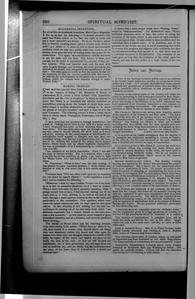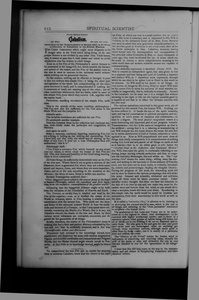< Ancient Theosophy (continued from page 3-133) >
on making inquiries he was told the story, which only rendered him more than ever anxious to hire the house. As evening closed in, he ordered a bed to be made up for himself in a front room, and called for writing materials and a light; then dismissed his attendants into the interior, and applied himself, mind, eye and hand, to the task of writing, that his brain might not be left free to conjure up the apparitions he had been told of, and torment him with idle fears. At first silence reigned supreme about him, is did everywhere else. Then there was a clash of iron and a shuffling of chains. So far, however, from lifting his eyes, or laying aside his peu, he redoubled attention to his work, and stopped his ears. The noise increased, and advanced nearer, until it seemed first at the door, and then in the chamber. He turned his head and saw a figure, which he recognized as the one described to him. It was standing beckoning with his finger, as if summoning him. He answered by a wave of the hand to wait a little, and resumed his writing. It proceeded to rattle the chains over his head. Then looking behind him again, and seeing it signalling as before, without further delay, he took up the candle, and followed it. The ghost walked slowly, as if encumbered by its chains; but after turning into the courtyard, it vanished suddenly, and left his companion alone. Finding himself thus he plucked some grass and leaves, and marked the spot The next day. he went before the magistrates, and advised them to order the place to be dug up. A skeleton was found entangled in a mass of chains, the body itself, from lying long in the ground, having rotted away, and left the bones, bare and mouldered, in the fetters. These were collected, and publicly buried; and the ghost having been duly laid, the house was haunted no more.
Waking Trances
Some months ago, the New York Sun published an article on the “Genius of Being:” Mr. Benjamin B. Blood, of Amsterdam, N. Y., wrote a book entitled “The Anesthetic Revelation and the Gist of Prophecy,” in which he labored to prove that “there is an invariable and reliable condition (or uncondition) ensuing about the instant of recall from anesthetic stupor to sensible observation, or ‘coming to,’ in which the genius of being is revealed," and sent a copy of it to the poet Tennyson. The following extract is from a letter which came in return, dated, “Faringford, Freshwater, Isle of Wight, May 7, 1874.
“I have never had any revelations through anesthetics, but a kind of “waking trance,’’ (this for the lack of a better word,) I have frequently had quite up from boyhood, when I have been alone. This has often come upon me through repeating my own name to myself silently, till all at once, as it were, out of the intensity of the consciousness of individuality the individuality itself seemed to dissolve and fade away into boundless Being—and this not a confused state, but the clearest, of the clearest, the surest of the surest, utterly beyond words—where death was an almost laughable impossibility the loss of personality (if so it were) seeming no extinction but only true life.
I am ashamed of my feeble description. Have 1 not said the state is beyond words? But in a moment, when 1 come back into my normal condition of sanity, I am ready to fight for “Meine Liebe Ich,” and hold that it will last for aeons of aeons:
In “Lucretius,” “What is duty,” was the first reading. It was altered because Lucretius nowhere, I think, makes any mention of duty in that sense; but it now stands again as at first”
Tennyson says, “This has often come upon me by repeating my own name to myself silently.” Is his experience a novel one? Let us examine the following: —
“Whenever I wish it,” says Cardan, “I come out of my body, so as to feel no sensation whatever, as if I were in ecstasy. When I enter this state, or, more properly speaking, when I plunge myself into ecstacy, I feel my soul issuing out of my heart, and, as it were, quitting it, as well as the rest of my body, through a small aperture formed at first in the head, and particularly in the cerebellum. This aperture, which runs down the spinal column, can only be kept open by very great efforts. In this situation feel nothing but the bare consciousness of existing out of my own body, from which I am distinctly separated; but I cannot remain in the state more than a few moments.” In this state be cured himself of gout, prescribed remedies, saw at a distance, and correctly predicted future events.
The monks of Mount Athos had the following formula, even more similar in its nature: “When thou art alone in thy call, shut thyself in a corner, raise thyself above all things vain and transitory, incline thy beard and chin upon thy breast, turn thine eyes and thoughts towards the middle of thy belly, the region of the navel, and search the place of the heart, the seat of the souk At first all will be dark and comfortless, but if thou perseveres! day and night thou wilt fad an ineffable joy, and no sooner has the' soul discovered the place of the heart than it is involved in a mystic and ethereal light.”
It seems that a more proper name than “Waking Trance” would be “Self-mesmerism.” Dr. Rutherford says, “Every individual possesses, more or less, the power of aiding the evolution of the brain, which is the result of rigid obedience to physiological laws. Mental action is thus ennobled, and the individual takes a higher place. It is, therefore, one of the greatest of our duties, not only to avoid everything that tends to reverse this progress and degrade brain evolution, but also to cultivate everything that can aid it, so that there may be a continual elevation of the individual. The evolution of the brain goes on long after the evolution of the other parts has ceased, and man has this power, to a large extent, in his own hands.”
Cabalism
The Chief Instrument which ought most diligently to be sougnt after is the Fire which being living of its own proper Nature is not vivified by any other Fire. From hence, also, it comes to pass that it hath power and virtue to vivify whatsoever else lies hidden in other things.
Even so is the Fire of the Philosopher's secret furnace to be accounted in the Spagyrick Art, which heateth the furnace and sphere of the vessel, and the Fire of the matter, even as the sun is seen to operate in the universal world without which nothing can be generated therein.
In like manner, nothing can be effected or brought to pass in this Art without this simple Fire; it being the chief part and operation of the whole Art, comprehending all the other parts therereof in itself, and is comprehended if nothing for it consisted of itself, not wanting any of the other; but all other operations whatsoever, that are made, stand in need of this simple Fire, from which they receive Life, together with the matter itself.
Paracelsus, speaking elsewhere of the simple Fire, saith thus:
This is the opinion of the most excellent philosophers. The Fire and Azo are sufficient, for the Fire alone is the whole Work and the complete Art.
Almadis saith:
The invisible Sunbeams are sufficient for our Fire.
He produceth another example.
That the Celestial Heat by his reflection and continual motion, doth chiefly make the perfection and coagulation of Mercury.
And again he saith:
Make a vaporous, continual, digesting, separating Fire, but not a flying or boiling up, but altering and penetrating; Now I have told, and that truly, the whole way of stirring up the Heat of this Fire; if thou art a true Philosopher thou will understand; this is it”
Salamanger saith:
“Our Fireis a corrosive Fire which burneth an airy cloud over our vessel, in which cloud the beams of this Fire are hid. This due chaos and humidity of the Cloud being wanting, there is error committed.”
All these things do sufficiently demonstrate unto us the Fire of the wise men. Where there is not so great a mixture of the Elements, there is generated Sol, where they are a little more mixed and impure, Luna, and where they are more imperfect, Venus, and so of the rest, according to the mutation of the Mixture; the Mine of every Metal is unlike one another.
Hermes Tresmigistus asserteth that—
“Thus Spagyrick work which is the utmost point of the hand of human Philosophy taketh the exordium and first beginning from the me dative contemplation of the greater world.”
Intimating that the Spagyrick Athanor ought to be built from the imitation of the Foundation of Heaven and Earth.
The Terrene, or earthly Sun, is kindled and bred by the Fire of the superior; even as is kindled the centre of oar World or Athanor, which is Fire, bearing a similitude and resemblance with the natural Sun. Who seeth not the form and frame of the universal created World to bear the similitude and likeness of a Furnace; or that I may speak more reverently, containing the Matrix of a Womb, that is to say, the Elements wherein the Seeds of the Sun and Moon by their various astral influences are corrupted, concocted, and digested for the generation of all things.
Briefly, therefore, the matter of the Philosophers’ stone is nothing else but a fiery and perfect Mercury extracted by Na <... continues on page 3-137 >
Editor's notes


